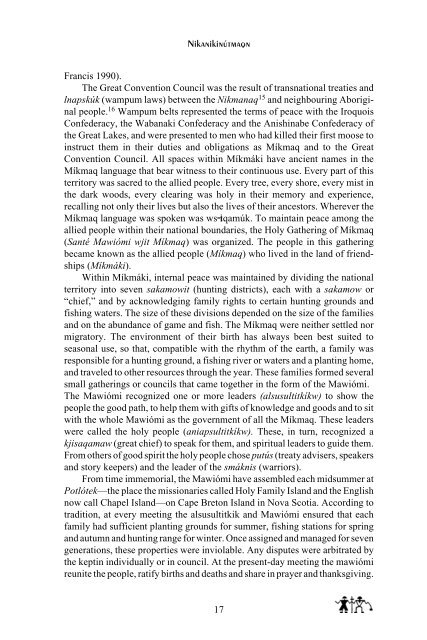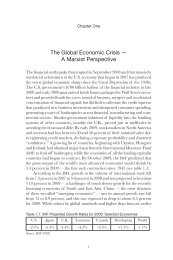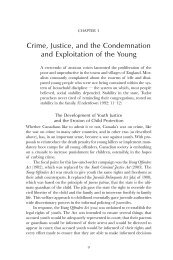Download PDF - Fernwood Publishing
Download PDF - Fernwood Publishing
Download PDF - Fernwood Publishing
Create successful ePaper yourself
Turn your PDF publications into a flip-book with our unique Google optimized e-Paper software.
Nikanikinútmaqn<br />
Francis 1990).<br />
The Great Convention Council was the result of transnational treaties and<br />
lnapskúk (wampum laws) between the Nikmanaq 15 and neighbouring Aboriginal<br />
people. 16 Wampum belts represented the terms of peace with the Iroquois<br />
Confederacy, the Wabanaki Confederacy and the Anishinabe Confederacy of<br />
the Great Lakes, and were presented to men who had killed their first moose to<br />
instruct them in their duties and obligations as Míkmaq and to the Great<br />
Convention Council. All spaces within Míkmáki have ancient names in the<br />
Míkmaq language that bear witness to their continuous use. Every part of this<br />
territory was sacred to the allied people. Every tree, every shore, every mist in<br />
the dark woods, every clearing was holy in their memory and experience,<br />
recalling not only their lives but also the lives of their ancestors. Wherever the<br />
Míkmaq language was spoken was ws itqamúk. To maintain peace among the<br />
allied people within their national boundaries, the Holy Gathering of Míkmaq<br />
(Santé Mawiómi wjit Míkmaq) was organized. The people in this gathering<br />
became known as the allied people (Míkmaq) who lived in the land of friendships<br />
(Míkmáki).<br />
Within Míkmáki, internal peace was maintained by dividing the national<br />
territory into seven sakamowit (hunting districts), each with a sakamow or<br />
“chief,” and by acknowledging family rights to certain hunting grounds and<br />
fishing waters. The size of these divisions depended on the size of the families<br />
and on the abundance of game and fish. The Míkmaq were neither settled nor<br />
migratory. The environment of their birth has always been best suited to<br />
seasonal use, so that, compatible with the rhythm of the earth, a family was<br />
responsible for a hunting ground, a fishing river or waters and a planting home,<br />
and traveled to other resources through the year. These families formed several<br />
small gatherings or councils that came together in the form of the Mawiómi.<br />
The Mawiómi recognized one or more leaders (alsusultitkíkw) to show the<br />
people the good path, to help them with gifts of knowledge and goods and to sit<br />
with the whole Mawiómi as the government of all the Míkmaq. These leaders<br />
were called the holy people (aniapsultitkíkw). These, in turn, recognized a<br />
kjisaqamaw (great chief) to speak for them, and spiritual leaders to guide them.<br />
From others of good spirit the holy people chose putús (treaty advisers, speakers<br />
and story keepers) and the leader of the smáknis (warriors).<br />
From time immemorial, the Mawiómi have assembled each midsummer at<br />
Potlótek—the place the missionaries called Holy Family Island and the English<br />
now call Chapel Island—on Cape Breton Island in Nova Scotia. According to<br />
tradition, at every meeting the alsusultitkik and Mawiómi ensured that each<br />
family had sufficient planting grounds for summer, fishing stations for spring<br />
and autumn and hunting range for winter. Once assigned and managed for seven<br />
generations, these properties were inviolable. Any disputes were arbitrated by<br />
the keptin individually or in council. At the present-day meeting the mawiómi<br />
reunite the people, ratify births and deaths and share in prayer and thanksgiving.<br />
17





